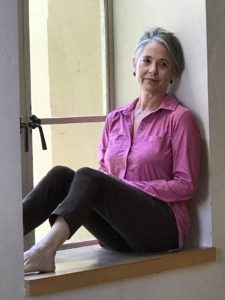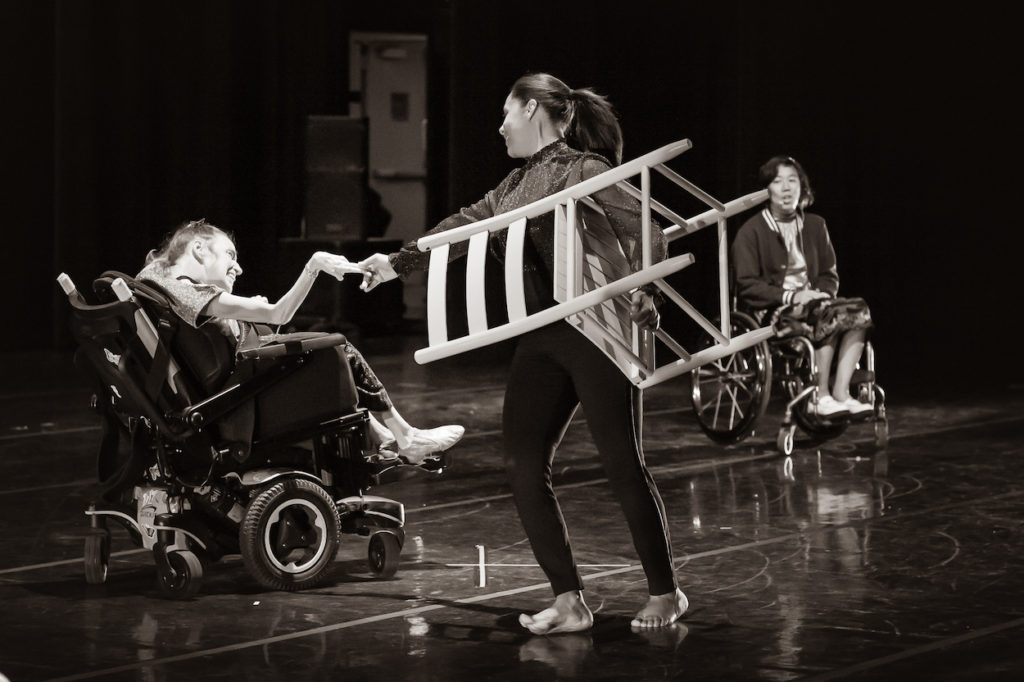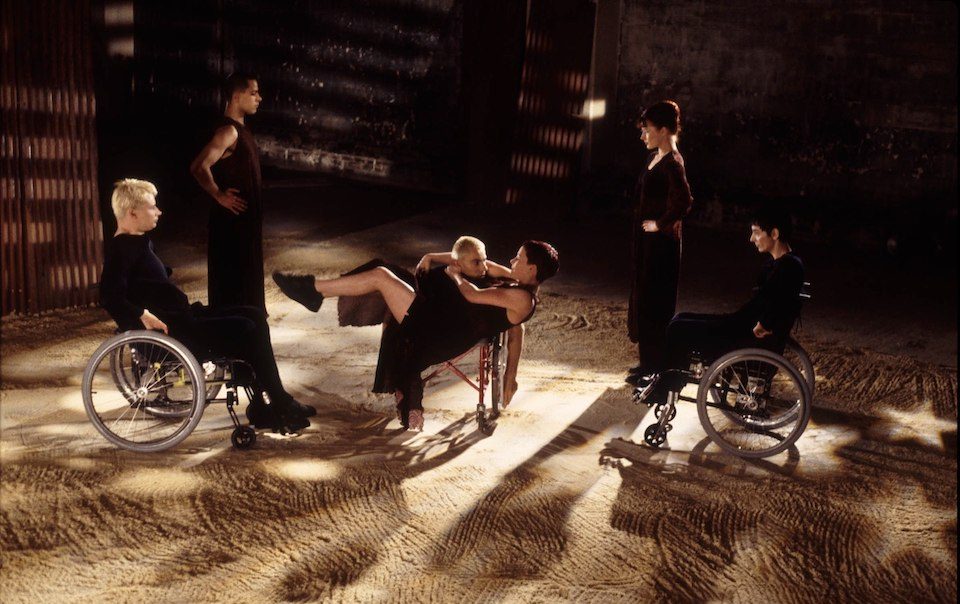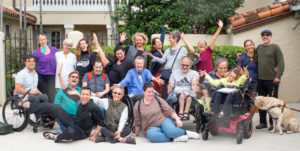Integrating Abilities: Victoria Marks pursues alliances and beauty - Vancouver Ballet Society
- Home
- Features 2020 - 2023
- Integrating Abilities: Victoria Marks pursues alliances and beauty

By Guillermo Perez
The questions Victoria Marks asks of dance can draw us into her work as forcefully as the firmest declarations. What stories should set a work in motion? Who gets to bask in the glow of the spotlight? How can the moving image of people with varied physical abilities create interest, wonder, alliance? This search foments a new way of seeing. And through it Marks exposes beauty in unsuspected places.
Considering what drives her, the artist ponders, “Can a dance point us in the direction of humanizing our lived experience?” An imperative, as much moral as it is aesthetic, guides this query: Avoid complacency, an enemy of both art and soul.

Even with an award-winning career spanning 40 years of stage, screen, and academic activity — with steady, amplifying advocacy for groups outside the mainstream — Marks says, “I don’t feel like an expert on anything.”
In an interview while in Miami last October to put the finishing touches on her commission for Forward Motion, an annual festival of physically integrated (PI) dance, the choreographer and creative facilitator further reflected, “Putting any dance together seems to me like such an improbable, extraordinary thing.”
But she does defy that improbability — and to fascinating effect. Time Being, her festival premiere for Karen Peterson and Dancers, which has produced the event four years running, was a collaboration with two normatively mobile performers and four in wheelchairs, including the score’s onstage pop-and-electronica composer, ONIKHO. The work was inspired by Rabbi Julia Watts Belser’s writings about seizing the moment (pay attention; notice beauty; nothing lasts forever) — here translated into seizing the momentum.
As Marks first got acquainted with the Miami-based cast from her Los Angeles home, she “started thinking what all these beautiful wheelchairs can do, but I can’t. And how they extend dancers’ bodies and their kinetic opportunities.” Eschewing the not-uncommon trope in PI dance of having wheelchair occupants figure as a sort of pedestal for their abled fellow dancers, the choreographer focused on the independent figures of the disabled. Their zip-by skills contrasted with those of ambulatory companions who laboriously maneuvered stationary chairs, as circular patterns dominated the choreography and coalesced centre stage in a lively collective.

This disabled-centric design connected with concerns — made more acute by the pandemic and the current social justice movement — that have bubbled up among participants in the Dancing Disability Labs Marks launched along with colleagues in 2019 at the University of California-Los Angeles, where she’s a professor in the Department of World Arts and Cultures and heads the Disability Studies Minor.
“With a sensibility of the moment, and the disabled feeling an increase in precariousness,” says Marks about the Labs, “exclusion of all kinds were in the forefront, and discussions became poignant from the perspective of the marginalized.”
She feels PI can fall into the trap of skirting the community’s basic issues “with a strong sense of able-ism at its core.” So she takes every opportunity to support “disability aesthetics,” attentive to the authentic voice of the disabled who bring “all their grace, control, and power.” This harmonizes with her admiration for intelligence and imagination in dancers not defined by a prescribed virtuosity, a viewpoint that enlivened her workshop with performers and community members at Forward Motion.

Marks’ artistic — and social — objectives display the openness that has long been her foundation. In 1993, she stepped away from performing with her own company in New York to go on an extended residency in London. That’s when she crossed into choreographing for PI on film with Outside In, directed by Margaret Williams and featuring Britain’s now venerable Candoco Dance Company. “My sense of dance-making changed forever,” Marks says about the experience. “A question I’ve had ever since is how the histories and context of movement inform dance.”
When the Candoco cast revealed their feelings of invisibility, she set off to create a piece that showed them as “glamorous, witty, sexy people,” with a playfulness that stressed how everyone leaves a mark. Her view of what dance can draw from expanded — “sneezing and kissing, breathing and gesture were all in the palette” — and film techniques extended visual opportunities.
“At that time in the global north, there was a fascination with the idea of neutrality — as if dancing could happen uninflected by culture and history,” Marks recalls. “Absurd now, right? Working with Candoco, I realized there cannot possibly be a neutral.”

Through the 1990s, other film collaborations with Williams featured a range of participants, and Marks developed her choreo-portraits — with in-depth profiles at the centre of creation — and docu-dramas — with interaction inside communities generating the narrative. In Mothers and Daughters, for example, intimate duos showed tender support as well as sly manipulation; Men portrayed a fraternity of elders in a mining centre near Banff, Alberta, with the artifacts of private lives set against the monumental Rocky Mountains.
All this segued into Action Conversations. Under Marks’ direction, these verbal and physical exchanges between diverse groups, otherwise rarely in contact, came to inform film and stage presentations. Their scenarios, brought to the screen by filmmaker Ann Kaneko, embraced teen mothers and older women in rural Vermont (2014’s Bellows Falls) and war veterans who shared their issues with artists and activists challenging notions of the heroic (2008’s Veterans). Right before lockdown — during which she presented carport performances at her home — Marks brought the hour-long Pastoral to the stage, countering with wry resourcefulness American dreams of fulfillment through the staking of new territory.

Up-and-coming musician ONIKHO — a former member of AXIS, the pioneering California PI company Marks has also choreographed for — praises the collaborative space of Forward Motion festival’s Time Being, in which “two artists from different generations and walks of life could come together and find common views. Victoria is thoughtful as an ally, and this experience renewed my sense of purpose as a disabled artist in shifting the narrative on able-ism and disability.”
That spirit of broad-based engagement keeps Marks fully charged for her busy, varied schedule. Lately, she confesses, “I’ve had a hard time going to sleep — I lie down vibrating with so many emotions!”
But such energy lights the path ahead. At UCLA, Marks will take up Action Conversations and the Dancing Disability Lab again, collaborate with emerging choreographers this spring, and finalize plans for a Disability Studies major before a sabbatical takes her to Guatemala for total immersion in a Spanish-language program. It’s quite a line-up for someone who chooses, as she puts it, to “thrive quietly within this complex dance and performance ecosystem.”

